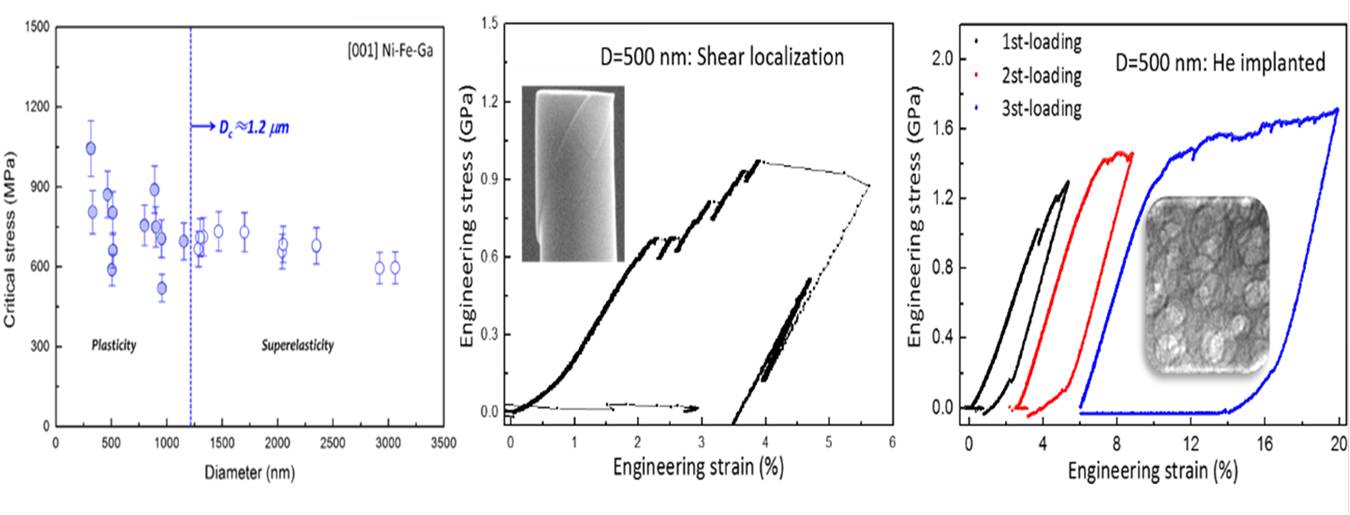Reported by Simian Liu
Shape memory alloy (SMA) is a class of
smart materials often used in micro actuators that demonstrates the shape
memory and superelasticity effects through reversible transformations between a
high-temperature austenite phase and a low-temperature martensite phase.
However, recent studies have shown that SMA has a strong size-dependence. With
the length scale of sample decrease, the stress induces martensite phase
increases until irreversible plastic deformation occurs and superelasticity
effect diminish. Therefore, the SMA performance of superelasticity failure at
micro- or submicroscales have restrain its application on micro actuators.

Recently, researchers from Campnano of Material Institute in XJTU ,by in-situ Nanomechanics technology, studied a kind of Ni–Fe–Ga shape memory alloy length scale effect systematically, showing that Ni–Fe–Ga shape memory alloy has a strong size-dependent superelasticity. When sample diameter is less than 1.2 μm, it results a transition from superelasticity to ODP/shear localization. Researchers suggested that the loss of superelasticity in shape memory alloy samples is due to the formation of stabilized martensites. With the reduction of the sample diameter, the stress induces martensite phase is larger than slip or shear localization stress. Therefore , the plastic deformation in these sampls are resulting from the ODP/shear localization rather than the nucleation of stabilized martensites. Based on this new micro mechanism, we implanted nanoscale helium bubbles to activated superelasticity of small-volume shape memory alloys. Helium nanobubbles have two important effects: first ,they are strong obstacles for dislocation slip,and have ability to block shear localization, promote martensite–martensite and martensite–bubble interactions and thus increase the yield stress. Second, they promote nucleation and compensate the surface energy contribution to the total free energy of martensitic phase transformation. The subsequent experiment confirmed that Ni–Fe–Ga pillars with the typical diameter of 500 nm across the high bubble density region show improved superelasticity. When at low applied strains, submicron-sized Ni–Fe–Ga pillars with helium bubbles show full superelasticty. When at high applied strains, the stress–strain response of helium bubbled pillars are very stable and show 2% recoverable strain and a low critical stress. Studies above indicated that the implantation of helium nanobubbles can improve the superelasticity and retard the tendency of shear localization by ODP in submicron-sized Ni–Fe–Ga pillars. This results may have an important effect on the application of shape memory alloy on micro actuators.
Research results above have applied for national invention patent and published online in Nano letters( IF:13.779, DOI:10.1021/acs.nanolett.7b01015)
The work was cooperated by Pro.Weizhong Han, Zhiwei Shan and JuLi, which was supported by the National Natural Science Foundation of China (Grant Nos. 51471128, 51231005, 51621063, and 51471184), Youth Thousand Talents Program of China, the National Key Research and Development Program of China (SQ2017YFGX090025), and the Young Talent Support Plan of XJTU.
Link: http://pubs.acs.org/doi/abs/10.1021/acs.nanolett.7b01015


